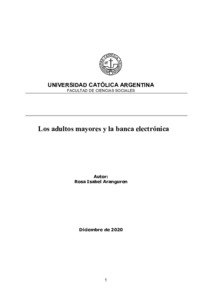Por favor, use este identificador para citar o enlazar este ítem:
https://repositorio.uca.edu.ar/handle/123456789/16740| Título: | Los adultos mayores y la banca electrónica | Autor: | Aranguren, Rosa Isabel | Director de Tesis: | Amadasi, Enrique Carlos | Palabras clave: | ADULTOS MAYORES; BRECHA DIGITAL; TECNOLOGIAS DE LA INFORMACION Y LA COMUNICACION; BANCA ELECTRÓNICA; INCLUSIÓN DIGITAL | Fecha de publicación: | 2020 | Cita: | Aranguren, R. I. Los adultos mayores y la banca electrónica [en línea]. Tesis de maestría. Pontificia Universidad Católica Argentina. Facultad de Ciencias Sociales, 2020. Disponible en: https://repositorio.uca.edu.ar/handle/123456789/16740 | Resumen: | Resumen: En esta tesis intentamos iluminar el proceso por el cual, después de casi diez años que el Estado implementara la bancarización previsional, un sector significativo de adultos mayores enfrenta dificultades para relacionarse con la banca electrónica, definida como la que incluye desde el uso de la tarjeta de débito y el cajero automático hasta las aplicaciones de home banking.
El interés de la investigación sobre los factores que podrían impedir el aumento de la inclusión del adulto mayor en la banca digital se vincula al hecho que el progreso hacia una mayor inclusión se desarrolla con lentitud y casi 50% de quienes hoy tienen 75 años o más no usa el cajero automático o home banking y prefieren cobrar sus haberes por ventanilla en la sucursal del banco.
Las proyecciones demográficas para Argentina señalan que la importancia de la población de adultos mayores sobre el total poblacional aumentará sin pausa hasta 2050. Paralelamente al crecimiento de la población de mayores, la velocidad de cambio de las tecnologías que usa la banca puede generar una ampliación en vez de un cierre de la brecha digital, si no se encuentra el modo de crear una banca “amigable” y un modo sencillo de explicar el uso de dichas tecnologías.
Para comprender la estructura de la población de adultos mayores en Argentina, se analizan las principales variables sociodemográficas, así como “las deudas” pendientes con este grupo tan numeroso y en crecimiento.
En la medida que pensamos que aún existe un problema para el adulto mayor, se revisaron los derechos de los que deben gozar, las normas legales locales e internacionales vigentes y en qué medida se aplican con el debido compromiso.
El marco teórico de la investigación se basa en el estudio sobre difusión de innovaciones desarrollado por E. Rogers, quien define y analiza la categoría de adoptantes tardíos o rezagados definidos como quienes toman un largo tiempo para aceptar una innovación.
Nos preguntamos de qué modo algunos adultos mayores califican en esta categoría, y si es posible que en algún momento puedan usar la banca electrónica de un modo más generalizado. Abstract: We try to understand why, after almost ten years from the date the government decided that social security payments would me be made thru the banking system, there is a group of elder adults unable to use or access to electronic banking, defined to include from debit cards and ATMs to home banking applications. We are interested in the understanding of the reasons that still prevent the inclusion of a group of senior citizens in electronic banking, as we see that the progress in that direction is very slow, considering that nowadays about 50%of those who 75 years old or more do not use the ATM or home banking and prefer to walk to the bank branch and withdraw fuds from one of the few available the tellers. Demographic projections for Argentina indicate that the importance of the elderly population as compared to total population will continue increasing until 2050. At the same time, the change in technologies, including those used in the banking industry will probably grow faster. This situation could lead to widening of the digital gap, instead of its narrowing. Therefore, as a society we need to create a "friendly" banking for our seniors and an easy way to explain the use of such technologies. To understand the structure of the elderly population in Argentina, we have analyzed the main sociodemographic variables, as well as actual deficits and debts with this group. To the extent that we believe that there is a problem for the eldest adult, we reviewed the rights they should enjoy, the local and international legal standards in force and to what extent they are applied with due diligence. The theoretical framework of this research is mainly based on the work of E. Rogers on diffusion of innovations, who defined a specific category of consumers: the laggards or late adopters, defined as those who take a long time before accepting an innovation. We wonder to what extent some of our older adults qualify in this category, and if it is possible for them at some point, they to become able to interact with electronic banking in a fluid way. To understand what reasons, have the older adults to deal with banks in different ways, we conducted individual interviews to understand what is behind their choices and what problems face in their daily transactions. Finally, we put on the table some recommendations to keep on board those who are already using electronic banking and to help narrowing the digital gap, to keep safe our older population. |
URI: | https://repositorio.uca.edu.ar/handle/123456789/16740 | Disciplina: | CIENCIAS SOCIALES | Derechos: | Acceso abierto | Fuente: | Tesis de maestría. Pontificia Universidad Católica Argentina. Facultad de Ciencias Sociales, 2020 |
| Aparece en las colecciones: | Tesis de Magíster en Sociología |
Ficheros en este ítem:
| Fichero | Descripción | Tamaño | Formato | |
|---|---|---|---|---|
| adultos-mayores-banca-electrónica.pdf | 1,85 MB | Adobe PDF |  Visualizar/Abrir |
Visualizaciones de página(s)
133
comprobado en 27-abr-2024
Descarga(s)
468
comprobado en 27-abr-2024
Google ScholarTM
Ver en Google Scholar
Este ítem está sujeto a una Licencia Creative Commons

